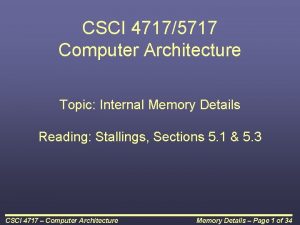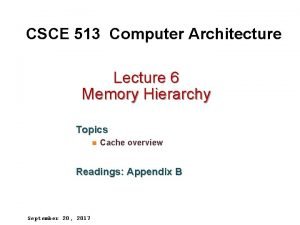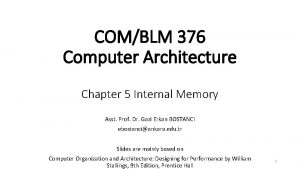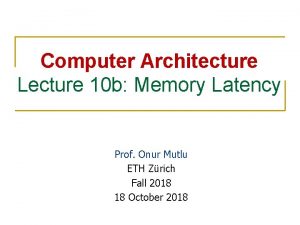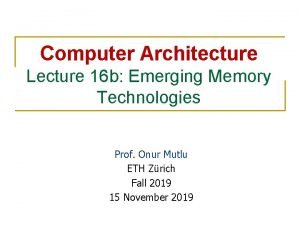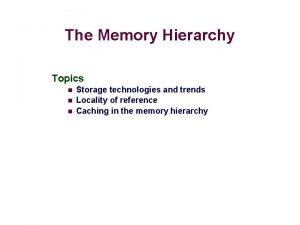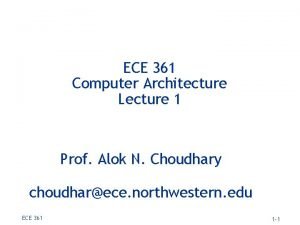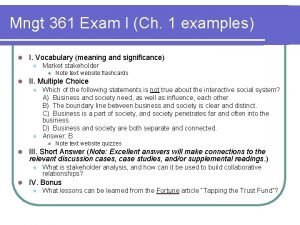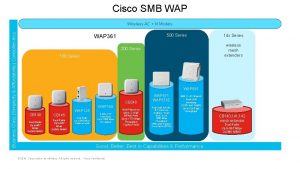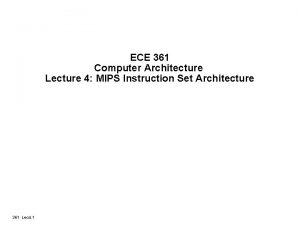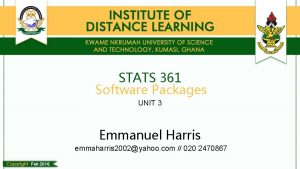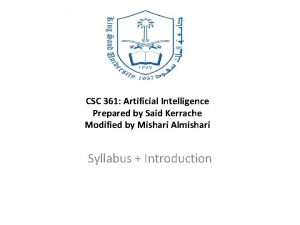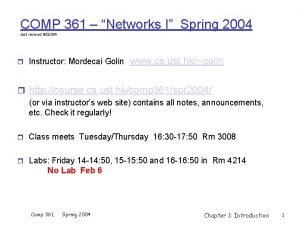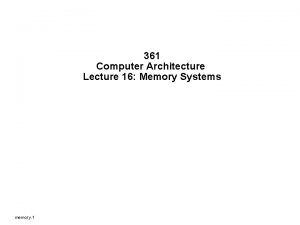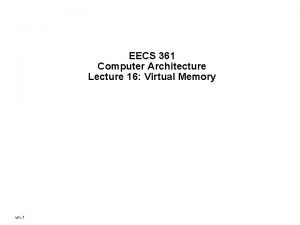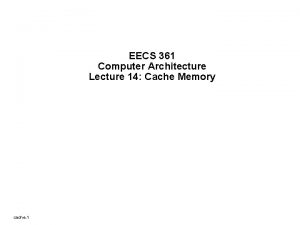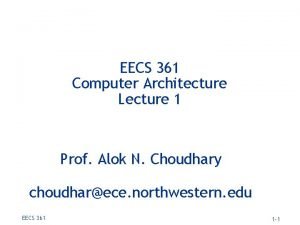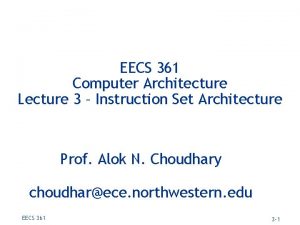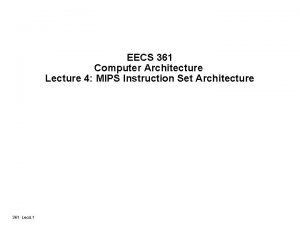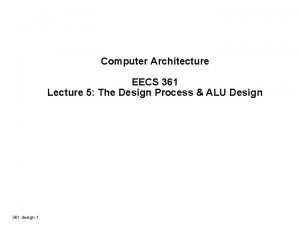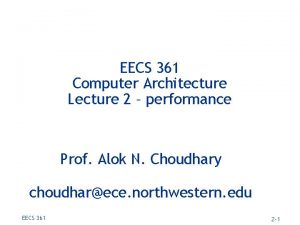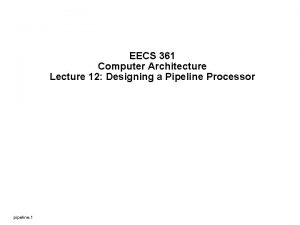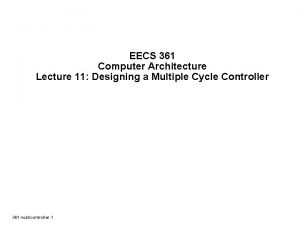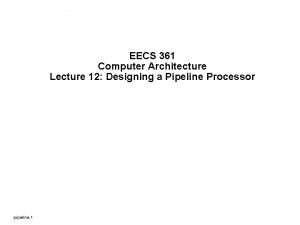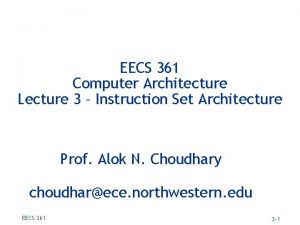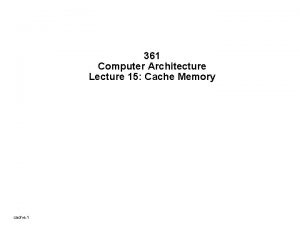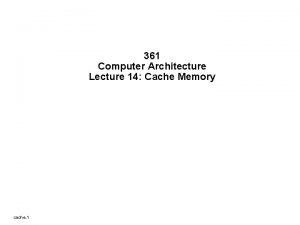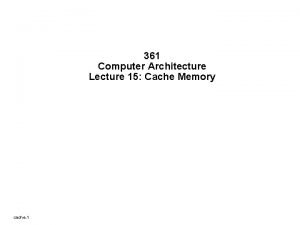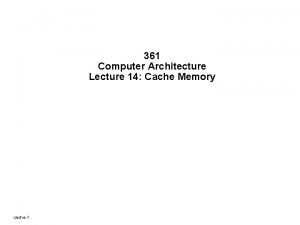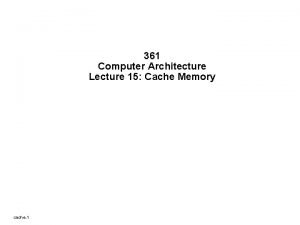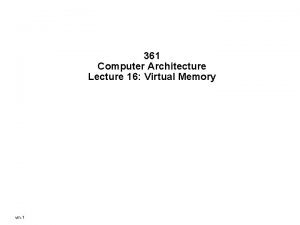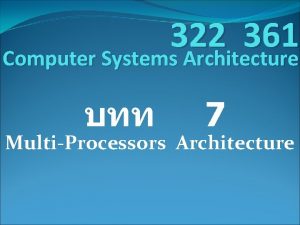EECS 361 Computer Architecture Lecture 16 Memory Systems






















- Slides: 22

EECS 361 Computer Architecture Lecture 16: Memory Systems memory. 1

Outline of Today’s Lecture ° Recap and Introduction ° Memory System: the BIG Picture? ° Questions and Administrative Matters ° Memory Technology: SRAM ° Memory Technology: DRAM ° A Real Life Example: SPARCstation 20’s Memory System ° Summary memory. 4

The Big Picture: Where are We Now? ° The Five Classic Components of a Computer Processor Input Control Memory Datapath ° Today’s Topic: Memory System memory. 5 Output

Memory Hierarchy of a Modern Computer System ° By taking advantage of the principle of locality: • Present the user with as much memory as is available in the cheapest technology. • Provide access at the speed offered by the fastest technology. Processor Control Speed (ns): 1 s Size (bytes): 100 s memory. 11 On-Chip Cache Registers Datapath 10 s Ks Second Level Cache (SRAM) Main Memory (DRAM) 100 s Ms Secondary Storage (Disk) 10, 000 s (10 s ms) Gs

Memory Hierarchy Technology ° Random Access: • “Random” is good: access time is the same for all locations • DRAM: Dynamic Random Access Memory - High density, low power, cheap, slow - Dynamic: need to be “refreshed” regularly • SRAM: Static Random Access Memory - Low density, high power, expensive, fast - Static: content will last “forever” ° “Non-so-random” Access Technology: • Access time varies from location to location and from time to time • Examples: Disk, tape drive, CDROM memory. 12

Random Access Memory (RAM) Technology ° Why do computer designers need to know about RAM technology? • Processor performance is usually limited by memory bandwidth • As IC densities increase, lots of memory will fit on processor chip - Tailor on-chip memory to specific needs - Instruction cache - Data cache - Write buffer ° What makes RAM different from a bunch of flip-flops? • Density: RAM is much more denser memory. 13

Technology Trends Capacity Logic: 2 x in 3 years Speed 2 x in 3 years DRAM: 4 x in 3 years 1. 4 x in 10 years Disk: 1. 4 x in 10 years 2 x in 3 years DRAM memory. 14 Year 1980 1983 1986 Size 64 Kb 256 Kb 1 Mb Cycle Time 250 ns 220 ns 1989 1992 1995 4 Mb 16 Mb 64 Mb 165 ns 145 ns 120 ns

Static RAM Cell 6 -Transistor SRAM Cell 0 0 word (row select) 1 1 bit ° Write: 1. Drive bit lines 2. . Select row ° Read: 1. Precharge bit and bit’ to Vdd 2. . Select row 3. Cell pulls one line low 4. Sense amp on column detects difference memory. 15

Typical SRAM Organization: 16 -word x 4 -bit Din 3 Din 2 Din 1 Din 0 Wr. En Precharge Wr Driver & - Precharger + SRAM Cell Word 1 SRAM Cell : : Word 15 SRAM Cell - Sense Amp + Dout 3 Dout 2 Dout 1 Dout 0 memory. 16 Address Decoder Word 0 A 1 A 2 A 3

Logic Diagram of a Typical SRAM A N WE_L OE_L 2 N words x M bit SRAM M D ° Write Enable is usually active low (WE_L) ° Din and Dout are combined: • A new control signal, output enable (OE_L) is needed • WE_L is asserted (Low), OE_L is disasserted (High) - D serves as the data input pin • WE_L is disasserted (High), OE_L is asserted (Low) - D is the data output pin • Both WE_L and OE_L are asserted: - Result is unknown. Don’t do that!!! memory. 17

1 -Transistor Cell ° Write: • 1. Drive bit line • 2. . Select row ° Read: • 1. Precharge bit line to Vdd • 2. . Select row bit • 3. Sense (fancy sense amp) - Can detect changes of ~1 million electrons • 4. Write: restore the value ° Refresh • 1. Just do a dummy read to every cell. memory. 19 row select

Introduction to DRAM ° Dynamic RAM (DRAM): • Refresh required • Very high density • Low power (. 1 -. 5 W active, . 25 - 10 m. W standby) • Low cost per bit • Pin sensitive: - Output Enable (OE_L) - Write Enable (WE_L) - Row address strobe (ras) - Col address strobe (cas) • Page mode operation memory. 20 ¦N r o w addr cell array N bits ¦N col log N 2 sense D one sense amp less pwr, less area

Classical DRAM Organization bit (data) lines r o w d e c o d e r row address Each intersection represents a 1 -T DRAM Cell Array word (row) select Column Selector & I/O Circuits data memory. 21 Column Address ° Row and Column Address together: • Select 1 bit a time

Typical DRAM Organization ° Typical DRAMs: access multiple bits in parallel • Example: 2 Mb DRAM = 256 K x 8 = 512 rows x 512 cols x 8 bits • Row and column addresses are applied to all 8 planes in parallel Plane 7 512 cols 512 rows Plane 0 One “Plane” of 256 Kb DRAM Plane 0 256 Kb DRAM D<1> D<0> memory. 22 256 Kb DRAM D<7>

Cycle Time versus Access Time Cycle Time Access Time ° DRAM (Read/Write) Cycle Time >> DRAM (Read/Write) Access Time ° DRAM (Read/Write) Cycle Time : • How frequent can you initiate an access? • Analogy: A little kid can only ask his father for money on Saturday ° DRAM (Read/Write) Access Time: • How quickly will you get what you want once you initiate an access? • Analogy: As soon as he asks, his father will give him the money ° DRAM Bandwidth Limitation analogy: • What happens if he runs out of money on Wednesday? memory. 26

Increasing Bandwidth - Interleaving Access Pattern without Interleaving: D 1 available Start Access for D 1 CPU Memory Start Access for D 2 Memory Bank 0 Access Pattern with 4 -way Interleaving: CPU Memory Bank 1 Access Bank 0 Memory Bank 2 Access Bank 1 Access Bank 2 Access Bank 3 We can Access Bank 0 again memory. 27 Memory Bank 3

Fast Page Mode DRAM ° Fast Page Mode DRAM • N x M “register” to save a row Column Address N cols DRAM Row Address N rows ° Regular DRAM Organization: • N rows x N column x M-bit • Read & Write M-bit at a time • Each M-bit access requires a RAS / CAS cycle M bits M-bit Output 1 st M-bit Access 2 nd M-bit Access RAS_L CAS_L A Row Address memory. 28 Col Address Junk Row Address Col Address Junk

Fast Page Mode Operation ° After a row is read into the register • Only CAS is needed to access other M-bit blocks on that row • RAS_L remains asserted while CAS_L is toggled N cols DRAM Row Address N rows ° Fast Page Mode DRAM • N x M “SRAM” to save a row Column Address N x M “SRAM” M bits M-bit Output 1 st M-bit Access 2 nd M-bit 3 rd M-bit 4 th M-bit Col Address RAS_L CAS_L A Row Address memory. 29 Col Address

SPARCstation 20’s Memory System Overview memory. 30 Processor Module (Mbus Module) Super. SPARC Processor External Cache Instruction Cache Data Cache Register File Memory Module 0 Memory Module 1 Memory Module 2 Memory Module 3 Memory Module 4 Memory Module 5 Memory Module 6 Memory Bus (SIMM Bus) 128 -bit wide datapath Memory Module 7 Processor Bus (Mbus) 64 -bit wide Memory Controller

SPARCstation 20’s Memory Module ° Supports a wide range of sizes: • Smallest 4 MB: 16 2 Mb DRAM chips, 8 KB of Page Mode SRAM • Biggest: 64 MB: 32 16 Mb chips, 16 KB of Page Mode SRAM DRAM Chip 15 512 cols 256 K x 8 = 2 MB 512 rows DRAM Chip 0 256 K x 8 = 2 MB 512 x 8 SRAM 8 bits<127: 0> 512 x 8 SRAM bits<7: 0> memory. 31 Memory Bus<127: 0>

SPARCstation 20’s Main Memory ° Biggest Possible Main Memory : • 8 64 MB Modules: 8 x 64 MB DRAM 8 x 16 KB of Page Mode SRAM ° How do we select 1 out of the 8 memory modules? Remember: every DRAM operation start with the assertion of RAS • SS 20’s Memory Bus has 8 separate RAS lines memory. 32 RAS 0 Memory Module 0 RAS 1 Memory Module 1 RAS 2 Memory Module 2 RAS 3 Memory Module 3 RAS 4 Memory Module 4 RAS 5 Memory Module 5 RAS 6 Memory Module 7 RAS 7 Memory Bus (SIMM Bus) 128 -bit wide datapath

Summary: ° Two Different Types of Locality: • Temporal Locality (Locality in Time): If an item is referenced, it will tend to be referenced again soon. • Spatial Locality (Locality in Space): If an item is referenced, items whose addresses are close by tend to be referenced soon. ° By taking advantage of the principle of locality: • Present the user with as much memory as is available in the cheapest technology. • Provide access at the speed offered by the fastest technology. ° DRAM is slow but cheap and dense: • Good choice for presenting the user with a BIG memory system ° SRAM is fast but expensive and not very dense: • Good choice for providing the user FAST access time. memory. 33
 Architecture lecture notes
Architecture lecture notes Isa definition computer
Isa definition computer Memory system design in computer architecture
Memory system design in computer architecture Explain virtual memory in computer architecture
Explain virtual memory in computer architecture Computer architecture
Computer architecture Internal memory in computer architecture
Internal memory in computer architecture Memory hierarchy
Memory hierarchy Memory organization in computer architecture
Memory organization in computer architecture Internal memory in computer architecture
Internal memory in computer architecture Memory latency in computer architecture
Memory latency in computer architecture Memory technology in computer architecture
Memory technology in computer architecture Memory heirarchy
Memory heirarchy Wa state rx services
Wa state rx services Ece 361
Ece 361 Mngt 361 exam 1
Mngt 361 exam 1 Wap 571
Wap 571 Ece 361
Ece 361 Stats 361
Stats 361 Hymn 361
Hymn 361 Darrieus vawt
Darrieus vawt Ece 361
Ece 361 Said kerrache
Said kerrache Comp 361
Comp 361





